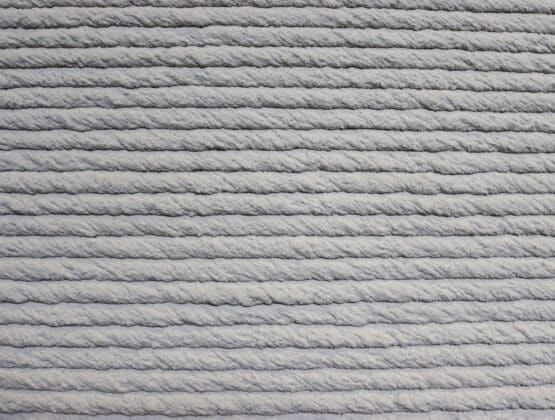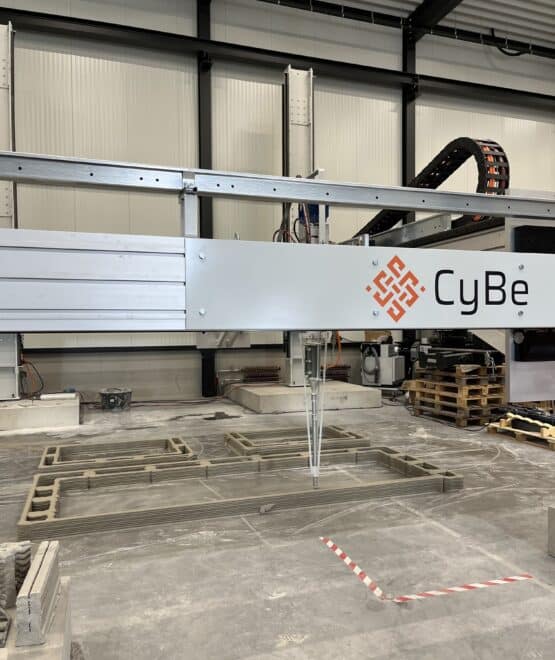What to know and how to choose the best printer for your company
Why 3D concrete printing?
If you are a future-focused company in the construction industry, you’ve probably heard something about 3D concrete printing. It’s an efficient method of building that minimizes materials and labor costs and maximizes production. Particularly in a housing shortage period, 3D concrete printers bring incredible value to the construction industry.

How do 3D concrete printers work?
3D concrete printers create structures layer-by-layer based on programmed input. CyBe’s printers use CyBe’s Chysel and Artysan software, which prepare 3D models for the printer and control the printing. The input from the software guides the printer, which positions itself and its printer nozzle in the correct location at the correct time. The printer constantly moves from coordinate to coordinate while extruding a steady stream of concrete.
Depending on the size of the structure, concrete mortars with varying set-times are used. For wall elements, a fast-drying mortar is ideal. CyBe’s specially developed, fast-drying CyBe Mortar sets in 3–5 minutes. One wall element can be printed within 1–2 hours. This makes it possible to print all the walls of one of our Lyve Design within 2 to 3 days. After 24 hours of hardening, elements can be hoisted and placed at their final location. For printing entire finished modules, a longer set-time is necessary to achieve wet-on-wet connection. Depending on the exact size of the print area, CyBe Mortar Gantry can set within 15–40 minutes.
CyBe mortars enable:
- Non-stop printing, critical for efficiency
- Wet-on-wet printing, critical for adhesion and strength
CyBe’s printers come with:
- Printing hardware
- Printing software
- Mix-pump system for concrete mortar
- Starter kit with spare parts for the printer
- Training for four print operators at any location

Choosing a 3D concrete printer
When purchasing 3D concrete printers, consider whether you will be printing:
- On-site or off-site (precast factory)
- Single-standing buildings or modular units
- Components or finished modules (such as finished apartments)
- Complex textures or standard shapes
These factors will help determine which 3D concrete printers are best for your company’s needs.
CyBe Robotic Crawler: ideal for on-site printing
The CyBe Robotic Crawler (RC) is a mobile 3D concrete printer and can be used in multiple locations. It can be used for off-site printing in a precast factory, but it is especially useful when printing on-site. This system uses an ABB robotic arm attached on a movable crawler with rubber tracks, which can easily maneuver over any terrain.
The capabilities of the CyBe Robotic Crawler include:
- Printing of elements (such as walls)
- Printing at any location
- Easy mobility over any terrain
- Fastest print speed on the market — 500 mm / second
- Printing up to 5 m in width and 4.5 m in height
- Printing complex textures with rotating nozzle option
- Excellent printing consistency for neat aesthetic results
The Robotic Crawler’s fast printing and low setup time is ideal for efficient on-site printing. Elements for individual buildings can be printed in one week. The construction timeline from site setup to finished building is five weeks. Multiple buildings within a project can be built continuously with a one-week gap between print locations.


CyBe Gantry: ideal for printing multi-unit, multi-story buildings
The CyBe Gantry (G) is a 3D concrete printer that can print anywhere within an established three-dimensional zone. It can be set up on-site, but it is best suited for printing large modules, such as finished apartments, in an off-site factory setting. This system is a stable setup of four columns and three beams and is ideal to create modular units.
The capabilities of the CyBe Gantry include:
- Printing modular units
- Fastest print speed on the market — 500 mm / second
- Large printing area – standard setup is 7m x 10m x 4m
- Customizable printing area size
- Excellent printing consistency for neat aesthetic results
The Gantry’s fast and large-scale capabilities make it ideal for printing multi-unit and multi-story buildings. Printing off-site with the Gantry system, modular units can be continuously printed in the factory and then transported and connected on-site. While printing on-site with the Gantry is possible, the setup and breakdown of the system requires one week before and after the printing, making off-site printing the most efficient print strategy.
